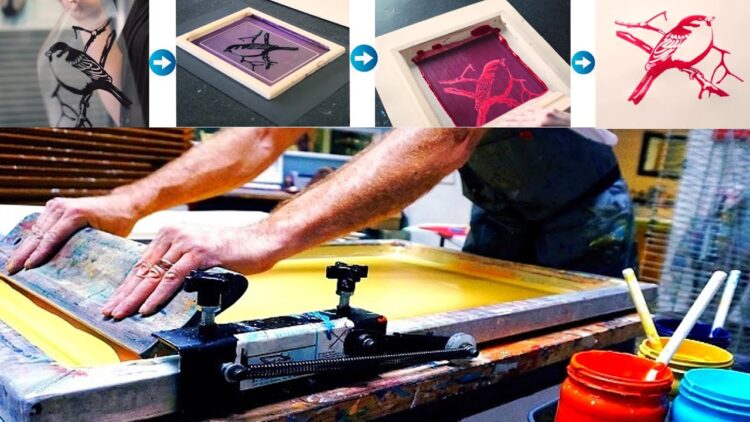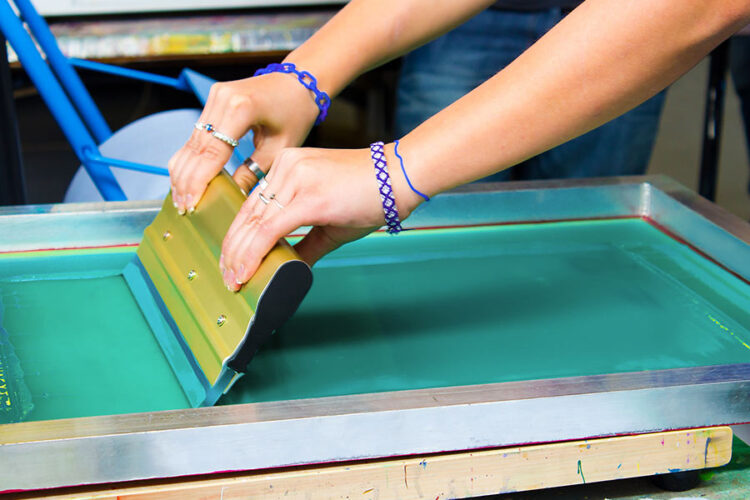Screen printers use a stencil-like structure to transfer and paint a textile surface or on a piece of glass that is placed beneath the stencil. Such techniques for printing textiles are quite old and require a lot of skill. The printing technique utilizes dyes, dye curing equipment, dye spraying equipment etc., to create vibrant colors on a piece of fabric.
So if you are keen on starting a screen printing business, you must look for screen printing supplies that are of good quality.
The Printing Technique Explained

The technique makes use of a screen that can be made of fabric or plastic. This screen is covered with a dye that is sensitive to light. The screen with the dye on it is burnt to create something that is akin to a stencil.
The stencil so created is used in such a way that the ink can seep through the stencil onto a surface which can be a ceramic block, a piece of glass or a piece of cloth. Once the ink has passed through the stencil, it is affixed tightly using elevated temperatures. (curing)
How Profitable Is A Screen Printing Business?

A Good Demand For The Printing Technique Increases Its Market Price
You can make a good amount of money by screen printing because there is a good demand for these prints. This printing technique can be used to print on a variety of surfaces, and the maximum demand comes from the packaging sector, which makes use of beautifully printed glass boxes.
Liquor bottles and decorative items made up of glass also make use of this printing technique. Apart from glass, polyester surfaces are also in great demand because they are more durable as compared to cotton.
At present, the biggest market for this industry is the US. However, most reports suggest that the Asian market will pose greater demands in the near future. The industry as a whole is expected to grow at 2 to 6% annually, and the market value of the industry is expected to exceed a thousand million US dollars by 2033.
Advantage Over Other Printing Techniques Has A Positive Impact On Price
In the case of screen prints, the surface can be coated with minute tags and these minute tags act as identifiers for originality. Apart from this, these tags can also provide information about the brand. So the ability to infuse minute tags into printed surfaces allows these prints to be authenticated as per the buyer’s will. So the chances of selling poor quality sub-standard products are minimized to a great extent.
The final products are resistant to damage by moisture or abrasive agents and hence, have greater acceptability than other printing techniques where the quality can deteriorate when exposed to moisture or chemical agents. In fact, these products are great for outdoor displays as the ink does not fade appreciably even when exposed to the elements of weather.
And finally, the thickness of the ink that is deposited on the surface can be regulated. This allows the final product to have an adequately thick deposit of ink, ensuring that the color does not bleed through on the other side of the fabric.
Latest Advances In Technology Are Driving Up The Price
The stencil-based printing technique can be highly profitable because the industry is adopting the latest advances in technology to improve the quality of the final product. For instance, the latest silicon polymer prints give the ink stretchability. So if silicon ink is deposited on a stretchable surface like elastic, then the ink will not crack despite stretching.
How To Improve The Profitability Of Your Printing Business

It is needless to say that the quality of any product will have an impact on the price it commands. So if you deliver good quality products, you will make a lot of money. Here are a few tips for delivering good-quality prints
Choose The Right Ink
The right kind of ink has a huge impact on the quality of the final product. There are different types of ink like water-soluble inks, plastisol-based inks etc. So choose an ink based on the final thickness, texture, and bleed-through required. Also, keep in mind the surface used for printing when selecting an ink. So the ink type will be different for a metallic surface vis-a-vis a glass or a plastic surface.
The right kind of ink also ensures that the final product is not excessively adhesive. A stick product can get stuck to packaging paper and create a nuisance at the unboxing stage.
Pay Close Attention To The Curing Process

The curing process helps in creating a solid cross-link between the dye and the surface. Usually, elevated temperatures are used for creating strong cross-links, but the quality of crosslinking depends on exposing the surface to the perfect curing temperature.
If anything goes amiss in the crosslinking stage, then the final products can develop cracks, or the color can fade away in a short span of time.
Prevent The Print From Becoming Fuzzy
If you choose the print surface incorrectly, then the final product can become fuzzy. For instance, if a fabric loses its integrity when exposed to high temperatures, then the final image or text that is printed will lose its sharpness. So it is vital to choose the right kind of material for depositing the dye.
Conclusion
You can make a lot of money if you venture into a screenprinting business. However, the final market value of your products will depend on the quality that you deliver. So try to gain expertise on the nuances of the technique before you invest money in the business.
Apart from the quality of the product, the competition in the market will also have an effect on the price that you command. The biggest challenge for the screen printing industry comes from digital prints, so ensure you deliver great quality, bright colors, and sharp images if you want to stay ahead of your competition.







